While Monarchs and Swallowtails often steal the spotlight in North America's butterfly world, two remarkable groups of butterflies deserve just as much attention: the Coppers and Metalmarks. These diminutive dynamos might be smaller than their famous cousins, but what they lack in size, they make up for in dazzling colors and fascinating behaviors. Found in diverse habitats from mountain meadows to coastal swamps, these butterflies play crucial roles in their ecosystems while treating observers to spectacular displays of natural jewelry.
This guide will introduce you to ten of North America's most captivating Coppers and Metalmarks, revealing their unique characteristics, preferred habitats, and the best ways to spot and support these winged wonders. Whether you're a seasoned lepidopterist or simply curious about the natural world, prepare to discover some of nature's most exquisite hidden gems.
Coppers
Meet the Coppers: These little guys are all about the bling—think striking coppery or orange hues that make them the life of the meadow party. Found in sunny spots, they're as much a joy to watch as they are rare.
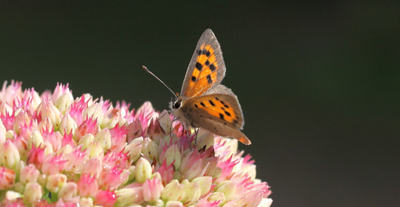
American Copper (Lycaena phlaeas)
- Boys vs. Girls: Both display bright copper wings with black spots; females typically larger with more pronounced spotting.
- Home Turf: Northeast U.S., extending into Midwest and southeastern Canada.
- Habitat: Open meadows, waste areas, roadsides, and gardens. Prefers sunny locations with low vegetation.
- Favorite Fuel: Primary nectar sources include clover, buttercups, and asters.
- Egg Drop Spot: Primarily sorrel plants, with sheep sorrel being the preferred host.
- Caterpillar Chow: Exclusively feeds on sorrel leaves (Rumex species).
- Behavior: Males are territorial, establishing and defending small patches of habitat. They actively patrol during sunny periods and engage in spiral courtship flights with females.
- Flight Period:
- Lowlands: April to October (2-3 broods)
- Mountains: June to August (single brood)
- Winter Stage: Overwinters as a caterpillar
- Adult Food: Beyond their primary nectar sources, they sometimes gather at mud puddles to obtain minerals.
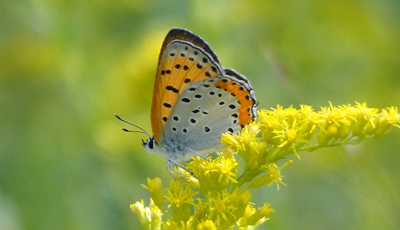
Bronze Copper (Lycaena hyllus)
- Boys vs. Girls: Males feature intense copper-orange coloring; females show more subdued tones with brown mixed in.
- Home Turf: Northeast and central United States.
- Habitat: Wetlands, marshes, wet meadows, and pond edges. Requires consistently moist conditions.
- Favorite Fuel: Milkweed, goldenrod, and thistles are preferred nectar sources.
- Egg Drop Spot: Dock plants, particularly curly dock and water dock.
- Caterpillar Chow: Exclusively feeds on dock leaves.
- Behavior: Males patrol low over vegetation in search of females. They're most active during morning and late afternoon hours.
- Flight Period:
- June to September (2 broods in south)
- July to August (1 brood in north)
- Winter Stage: Overwinters in chrysalis form
- Adult Food: Besides nectar, adults occasionally gather at damp soil for minerals.

Purplish Copper (Lycaena helloides)
- Boys vs. Girls: Males smaller with vibrant purplish-copper coloring; females more muted with wider black borders.
- Home Turf: West Coast, Rocky Mountains, Pacific Northwest, some Midwestern wetlands.
- Habitat: Moist meadows, stream edges, and mountain valleys up to 10,000 feet elevation.
- Favorite Fuel: Asters, buttercups, and milkweed are primary nectar sources.
- Egg Drop Spot: Dock and smartweed plants.
- Caterpillar Chow: Larvae feed exclusively on dock and smartweed.
- Behavior: Males actively patrol territories during sunny periods, engaging in aerial battles with other males.
- Flight Period:
- Lowlands: March to November (multiple broods)
- Mountains: June to September (single brood)
- Winter Stage: Overwinters as egg or early instar caterpillar
- Adult Food: Nectars from various flowers; shows strong preference for purple and yellow blooms.

Lilac-bordered Copper (Lycaena nivalis)
- Boys vs. Girls: Males show coppery coloration with distinctive lilac edge on hindwings; females more subtle with broader black markings.
- Home Turf: Mountainous regions from California to Montana.
- Habitat: Alpine meadows, mountain slopes, and subalpine clearings, typically above 5,000 feet.
- Favorite Fuel: Alpine flowers including buttercups, cinquefoils, and asters.
- Egg Drop Spot: Knotweed and dock plants in alpine environments.
- Caterpillar Chow: Larvae feed on knotweed and dock leaves.
- Behavior: Males establish territories on hilltops, engaging in aerial pursuits of females.
- Flight Period:
- June to August (single brood)
- Later at higher elevations
- Winter Stage: Overwinters as egg
- Adult Food: Primarily alpine flowers; rarely observed puddling.
Metalmarks
Get to Know Metalmarks: These butterflies are small, but their metallic spots make them stand out like nature's little jewels. They love specialized habitats, and their metallic sheen adds a touch of bling to the butterfly world.

Northern Metalmark (Calephelis borealis)
- Boys vs. Girls: Both sexes feature brown wings with silver spots; females slightly larger.
- Home Turf: Isolated populations in eastern U.S., particularly in Appalachians and Midwest.
- Habitat: Limestone-rich areas, woodland clearings, and rocky slopes with specific host plants.
- Favorite Fuel: Milkweed, butterflyweed, and coneflowers.
- Egg Drop Spot: Roundleaf ragwort exclusively.
- Caterpillar Chow: Larvae feed solely on roundleaf ragwort leaves.
- Behavior: Adults are sedentary, rarely straying far from host plant colonies.
- Flight Period:
- June to August (single brood)
- Winter Stage: Overwinters as partially grown caterpillar
- Adult Food: Limited nectar sources; rarely observed feeding far from host plants.
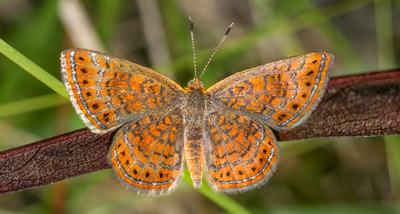
Swamp Metalmark (Calephelis muticum)
- Boys vs. Girls: Both show small brown wings with silver spots; pattern intensity varies.
- Home Turf: Midwest swamps, particularly Mississippi and Ohio River Valleys.
- Habitat: Calcareous fens, wet prairies, and swamp edges with host plants.
- Favorite Fuel: Swamp thistle, milkweed, and dogbane.
- Egg Drop Spot: Exclusively on swamp thistle.
- Caterpillar Chow: Larvae feed only on swamp thistle.
- Behavior: Very localized, with adults staying close to host plant patches.
- Flight Period:
- July to August (single brood)
- Winter Stage: Overwinters as partially grown caterpillar
- Adult Food: Limited nectar sources within swamp habitat.
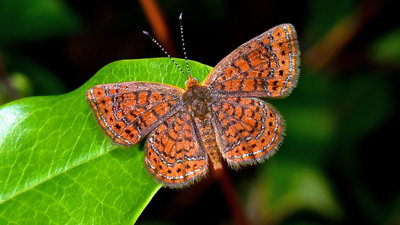
Little Metalmark (Calephelis virginiensis)
- Boys vs. Girls: Both small with brownish wings and metallic spots; males smaller and more active.
- Home Turf: Southeast U.S., especially Florida, Georgia, and Carolinas.
- Habitat: Sandy areas, pine flatwoods, and coastal plain habitats.
- Favorite Fuel: Aster, goldenrod, and fleabane.
- Egg Drop Spot: Asteraceae family plants, especially black-eyed Susan.
- Caterpillar Chow: Larvae feed exclusively on black-eyed Susan leaves.
- Behavior: Males patrol small territories during sunny periods.
- Flight Period:
- March to November in Florida (multiple broods)
- May to September further north
- Winter Stage: Overwinters as caterpillar in southern range
- Adult Food: Various nectar sources; shows preference for yellow composite flowers.
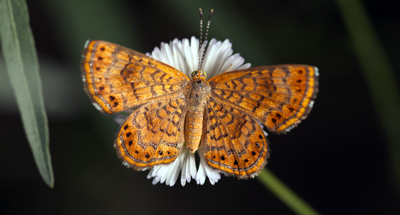
Fatal Metalmark (Calephelis nemesis)
- Boys vs. Girls: Dark brown wings with silver spots and wavy orange lines; females have broader wings.
- Home Turf: Southwest U.S. (Texas, Arizona, New Mexico) and Mexico.
- Habitat: Arid scrubland, desert washes, and canyon bottoms.
- Favorite Fuel: Desert plants including lantana, verbena, and sagebrush.
- Egg Drop Spot: Frogfruit and other low-growing plants.
- Caterpillar Chow: Larvae feed exclusively on frogfruit leaves.
- Behavior: Adults stay close to ground level, often resting under leaves during intense heat.
- Flight Period:
- March to November in desert lowlands (multiple broods)
- May to September in higher elevations
- Winter Stage: May breed year-round in warmest regions
- Adult Food: Various desert flowers; most active during cooler morning hours.
Coppers and Metalmarks may be small, but they're the hidden gems of North America's butterfly world. Their vibrant colors and unique habitats make them fascinating to butterfly enthusiasts and essential to the ecosystem. By planting the right nectar and host plants, you're not just inviting these beauties into your garden—you're helping to keep their species thriving. So, let's roll out the green carpet for these little wonders!
































































































































































































































































































































































































































































































































































































































































